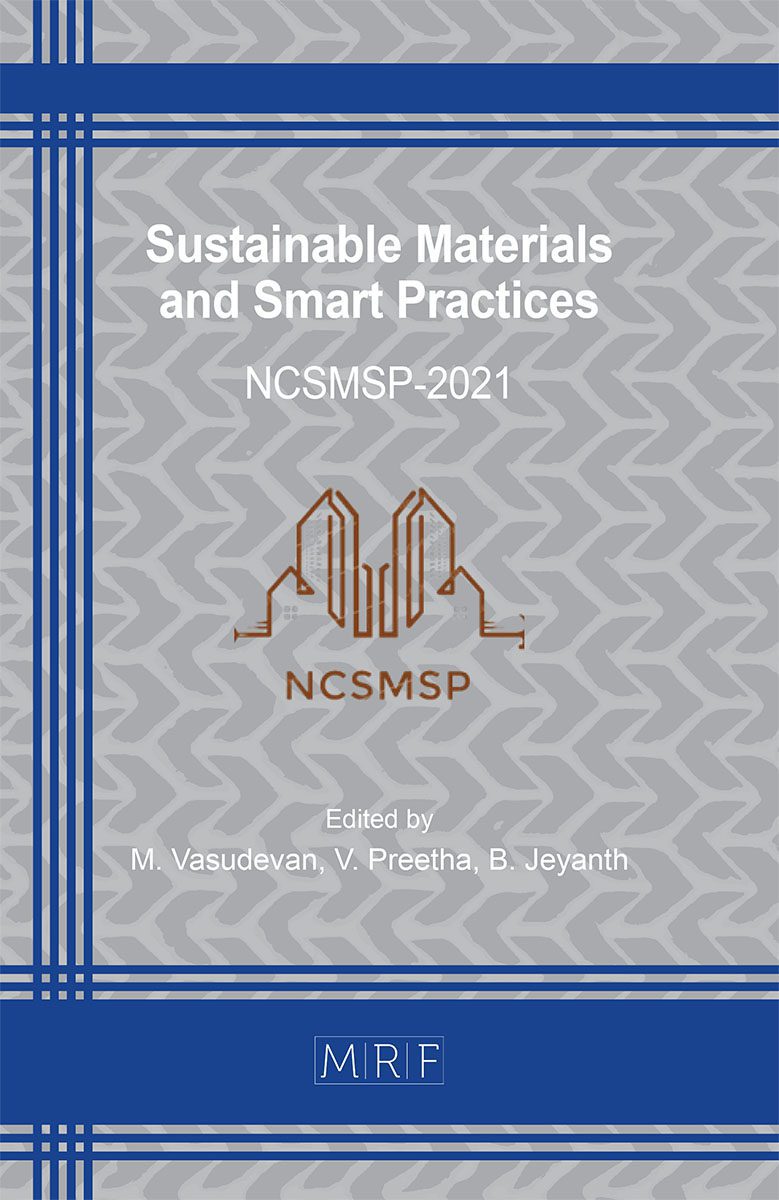Performance Evaluation of RCC Beam Column Joint with Aramid Fibre
V. Jayanthi, S. Mehala, P. Rajesh Kumar
download PDFAbstract-In reinforced concrete structure beam, the beam column joints are more crucial zones which are most susceptible to failure during earthquake excitation. It is very important to design the joint to dissipate the large amount of energy to the neighbouring elements without loss of strength and ductility. Several retrofitting methods are employed to strengthen the beam column joint. The effective method one among is Fibre Reinforced Polymer (FRP) composites. In this paper, the deflection of beam column joint wrapped with aramid fibre has been calculated and it is compared with Ansys software solution. From the results, the deflection of the joint is decreased when aramid fibre is used.
Keywords
Column Joint, Aramid Fibre, Moment Resistance Earthquake
Published online , 7 pages
Copyright © 2022 by the author(s)
Published under license by Materials Research Forum LLC., Millersville PA, USA
Citation: V. Jayanthi, S. Mehala, P. Rajesh Kumar, Performance Evaluation of RCC Beam Column Joint with Aramid Fibre, Materials Research Proceedings, Vol. 23, pp 9-15, 2022
DOI: https://doi.org/10.21741/9781644901953-2
The article was published as article 2 of the book Sustainable Materials and Smart Practices
![]() Content from this work may be used under the terms of the Creative Commons Attribution 3.0 licence. Any further distribution of this work must maintain attribution to the author(s) and the title of the work, journal citation and DOI.
Content from this work may be used under the terms of the Creative Commons Attribution 3.0 licence. Any further distribution of this work must maintain attribution to the author(s) and the title of the work, journal citation and DOI.
References
[1] Abdullah, M. M. and Jallo. E. K. (2012). “Mechanical properties of glass fiber reinforced concrete.”Al-Rafadain Engineering Journal, Vol.20, No.5, pp.128-135. https://doi.org/10.33899/rengj.2012.61048
[2] T. T. Soong and G. F. Dargush, Passive Energy Dissipation Systems in Structural Engineering, Wiley, 368.
[3] Junji Takagi, Some Properties of glass fiber reinforced concrete, fiber reinforced concrete, ACI SP-44, Detroit, Michigan, 1974, PP. 93-111 .
[4] Adaganti, S. Y. (2014). “Recovery and re-use of Glass fibers for composite reinforcements.” Journal of Scientific and Industrial Research, Vol. 73, No. 10, pp. 671-673.
[5] JongsungSim, Park, C & Moon, D 2005, ‘Characteristics of basalt fiber as a strengthening material for concrete structures’, Composites, Vol. 36, pp.504-512. https://doi.org/10.1016/j.compositesb.2005.02.002
[6] Li, W & Xu, J 2009, ‘Mechanical properties of basalt fiber reinforced geopolymeric concrete under impact loading’, Materials Science and Engineering, Vol. 505, pp. 178-186. https://doi.org/10.1016/j.msea.2008.11.063
[7] Ludovico, M., Prota, A., &Manfredi, G., 2010, ‘Structural upgrade using basalt fibers for concrete confinement’, Journal of Composites for Construction, Vol.14, pp.541-552. https://doi.org/10.1061/(ASCE)CC.1943-5614.0000114
[8] Lopresto V., Leone C., &Iorio, D., 2011, ‘Mechanical characterization of basalt fiber reinforced plastic’, Composites, Vol.42, pp. 717-723. https://doi.org/10.1016/j.compositesb.2011.01.030
[9] Manikandan V., Jappes, W., Kumar, S., &Amuthakkannan, P 2012 ‘Investigation of the effect of surface modifications on the mechanical properties of basalt fiber reinforced polymer composites’, Composites, Vol. 43, pp.812-818. https://doi.org/10.1016/j.compositesb.2011.11.009
[10] Quagliarini, E., Monni, F., Lenci, S., &Bondioli, F., 2012, ‘Construction and Building Materials’, Vol. 34, pp. 372-380. https://doi.org/10.1016/j.conbuildmat.2012.02.080
[11] Shi, J., Zhu, H., Wu, Z., Seracino, R., & Wu, G., 2013, ‘Bondbehavior between basalt fiber–reinforced polymer sheet and concrete substrate under the coupled effects of freeze-thaw cycling and sustained load’, Journal of Composites for Construction, Vol. 17, pp.530-542. https://doi.org/10.1061/(ASCE)CC.1943-5614.0000349
[12] Yuan, F., Pan, J., & Leung CKY 2013, ‘Flexural behaviors of ECC and concrete / ECC composite beams reinforced with basalt fiber-reinforced polymer’, Journal of Composites for Construction, Vol. 17, pp. 591-602. https://doi.org/10.1061/(ASCE)CC.1943-5614.0000381































